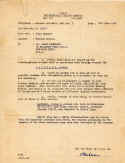
Saga of a German-Jewish Family
Their efforts to emigrate having failed, Julius and Meta were arrested by the Gestapo in 1942. They were transported to various locations in the east and finally ended their journey in Riga, Latvia.
Although Jewish economic ties to Riga date from the 16th Century, Jews were not permitted to reside there until the 18th Century. From 1710-1917, the city was under Russian rule. After the establishment of the independent Latvian Republic, Riga became the capital of the new state, and its Jewish population grew from about 25,000 (13.6 of the total) in 1920 to 39,000 (11.68) in 1925, 42,000 (11.20) in 1930, and 44,000 (11.34) in 1935.
On July 1, 1940, nine days after their invasion of the Soviet Union, the Germans occupied Riga. At that time, there were about 40,000 Jews in Riga. Anti-Jewish attacks began immediately, including the destruction of the synagogues. In August, 1941, Jews were ordered into a ghetto in a suburb of Riga. About 30,000 persons were confined to an area of 96,875 square feet. On November 19, 1941, the Germans separated the working Jews from the rest of the ghetto inhabitants, moving them into a separate area that became known as the "small ghetto".
On the night of November 30, 1941, the "large ghetto" was surrounded by German and Latvian guards. The Jews inside were gathered into groups, each numbering a thousand persons. The next morning these groups were taken to the Rumbula Forest, five miles from Riga, where they were shot to death. Over the next few days, about 25,000 Jews were killed in this manner, leaving only the 4,000 Jews in the "small ghetto".
Having emptied the "large ghetto", the Germans began to repopulate it with Jews deported from Germany, including the Lachmanns. This new deportees were set up as a separate ghetto with its own Judenrat (Jewish Administration) and became known as the "German ghetto". Between December, 1941, and the spring of 1942, about 16,000 Jews were brought into the "German ghetto". Several Jewish labor camps were also established in Riga and the vicinity. On November 2, 1943, an "Aktion" took place, in which the old, the very young, and the sick were murdered. Afterward the ghetto was liquidated, and the surviving Jews taken to Kaiserwald concentration camp, near Riga. Latvian and other local inhabitants collaborated with the Nazis in the persecution and murder of Jews. In the summer of 1944, as a result of the Soviet offensive in the Baltic area, the Kaiserwald concentration camp was liquidated, and the remaining Jews deported to various camps in Germany; few of them survived. When the Soviet army liberated the area on October 13, 1944, only 150 Jews were found in various hiding places.
In 1945, the International Tracing Service was founded the Supreme Headquarters, Allied Expeditionary Forces. Since 1955 it has been directed by the International Committee of the Red Cross in Geneva, though financed by the German Federal Republic. The archives contain nominal records of inmates of German concentration camps from 1933 to 1945, of foreigners who worked in Germany during World War II, and of Displaced Persons in Western Europe immediately after the war. There are approximately 2,500,000 pages of lists and 8,000,000 individual records. New documents are continually acquired. There is a master index of 28,000,000 reference cards for the records which are classified exclusively for the checking of individual cases. Excerpts from documents are established according to subject matter, such as deportation, detention in concentration camps, or death in such a camp. Since 1955 a staff of more than 200 persons has answered about 150,000 inquiries annually.
After the war, Jacob Lachmann, a relative residing in New York, sent an enquiry to the International Tracing Service regarding the fate of Julius. Below is a thumbnail of a letter, dated June 17, 1949, in the response to this enquiry. The letter confirms that Riga was an extermination center and implies that there was virtually no chance that Julius survived. Please click on the thumbnail to see the full image, and then click your back key or "Letter from ITS" in the left frame to return.
Encyclopedia Judaica, CD-Rom Edition, Keter Publishing
Encyclopedia of the Holocaust, MacMillan Publishing, 1990, P. 1276-79
Das Nationalsozialistische Lagersystem, Herausgegeben von Martin Weinmann
![]()
Copyright © 1998 Edward Victor